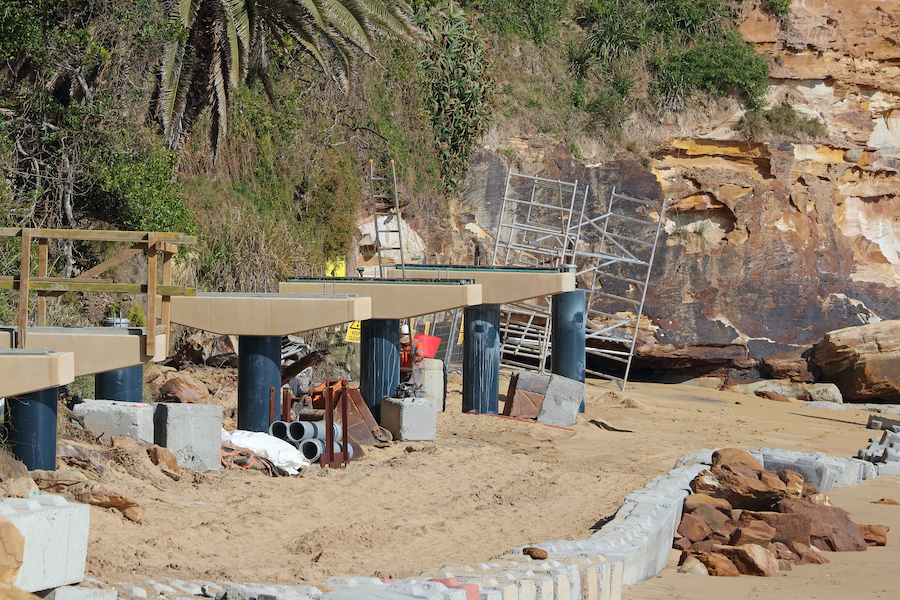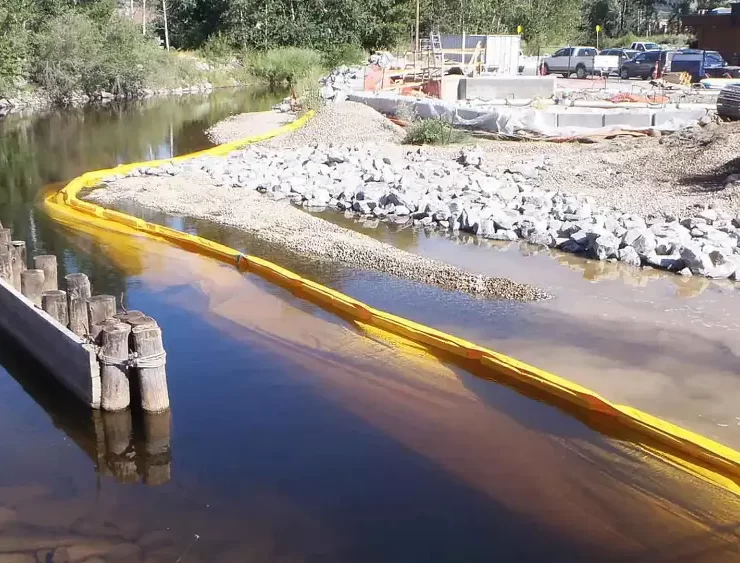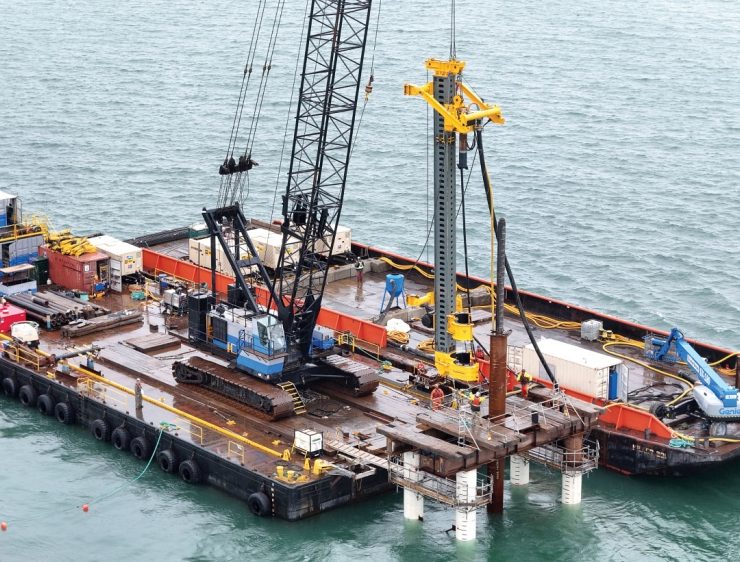Coastal Foundations Guide Part I – Risks, Environment Challenges, Building Codes, and More


A structure’s foundation determines its longevity and ability to handle the stresses of time, use, and Mother Nature. Some construction sites present challenges such as sloping or unusual soils. Building in coastal areas is particularly challenging. In this first part of our series on coastal foundations we discuss those challenges. In subsequent installments, we cover different types of coastal foundations and best practices.
Coastal Foundation Risks
The beauty of a coastline is hard to resist. The vast majority of coastlines in the United States are densely populated and lie less than 20 feet above sea level. This greatly increases the risk of storm surges. Despite the risks, people keep building near the water. Unlike inland foundations, buildings near water are exposed to erosion and scour, breaking waves, high velocity storm surge flow, moving floodwaters, and floodborne debris. A coastal foundation must support the load of the building despite the forces of weathering and corrosion that are particularly harsh in coastal areas.
Coastal Environment Challenges
FEMA describes these specific challenges to designing coastal foundations:
- Wave action, erosion, and storm surge typically result in more damage compared to inland flooding.
- Buildings usually need to be higher off the ground in coastal areas.
- When floodwaters destroy weaker buildings in coastal areas, they expose the foundations of other structures to floodborne debris.
- Erosion and scour can destroy foundations and cause the building to fail.
- Wind speeds are often higher in coastal area and require buildings and their foundations to be stronger to handle the additional load.
- Buildings must be elevated high enough to avoid flooding.
- Building design must minimally meet National Flood Insurance Program (NFIP), as well as state and local floodplain management, requirements.
- The building must be designed to withstand anticipated erosion and scour throughout the entire life of the structure.
- The foundation must be designed to protect the building against flotation, collapse, and lateral movement.
Building Codes
Inland foundations are designed mainly to handle wind and seismic loads. These loads are well understood by building professionals. Long-standing, established building codes exist to guide the inland foundation design. Sections within the International Building Code (IBC) provide detailed requirements for foundation design meant to handle wind and seismic loads. There are literally decades of reliable historical data.
Flood Criteria
Performance-based standards for flood criteria were first presented in 1995. Twenty-five years may sound like a long time, but there still is not enough data to develop prescriptive codes and standards for flood design. Presently, there are not “off-the-shelf” flood-resistant designs for coastal area construction.
FEMA Documents
The Federal Emergency Management Agency (FEMA) does provide some prescriptive design guidance for coastal foundations, including FEMA 550 and 499. There are several FEMA technical fact sheets as well:
Local Experience
Coastal foundation design must rely at least in part on local professionals. Their judgment on decisions regarding coastal issues, such as erosion, will be based on their knowledge of local historical data and trends. In some cases, it may be necessary to rely solely on local experience. However, FEMA does provide resources to building professionals.
Building Codes and Coastal Foundations
Some sections of the International Building Codes (IBC) do regulate coastal construction. For example, IBC Section 1603.1.6 requires that local flood conditions and elevations be specified in the construction documents for a home is located in a Special Flood Hazard Area (SFHA). Homes in a “V Zone” — where there is a risk of high-velocity wave action – requires that their foundations resist all flood forces.
Zone-Based Construction
The National Flood Insurance Program (NFIP) determines flood risk by zone. Zone A and Zone V are high-risk coastal areas. However, FEMA discusses a “Coastal Zone A” in its documentation to make a distinction between buildings more inland and those much closer to water. So, design and construction recommendations for “Coastal Zone A” buildings will be closer to the higher-risk Zone V guidelines.
Coastal A Zone Definition
FEMA defines Zone A as “areas with a 1% annual chance of flooding and a 26% chance of flooding over the life of a 30‐year mortgage.” A building becomes a Coastal A Zone structure when a flood event can result in a 1.5-foot-high breaking wave. Note that the Flood Insurance Rating Map (FIRM) does not yet specify Coastal Zone A. It is up to designers, owners, and local communities to make that determination. Generally, where stillwater depths are about two feet is the delineation. The bottom line is that even smaller breaking waves can destroy concrete or masonry foundation walls that are not properly reinforced.
V Zone Construction
FEMA defines Zone V also as “areas with a 1% annual chance of flooding and a 26% chance of flooding over the life of a 30‐year mortgage.” However, Zone V areas also have an additional hazard due to storm waves.
Due to the anticipated failure of conventional closed foundations in Coastal A Zones, V Zone construction (or at least near-V Zone construction) is recommended to ensure the longevity of Coastal A Zone buildings. In V Zone construction, a structure is placed upon a deep, open foundation. For example, although the NFIP allows closed foundations with flood-equalizing vents in Coastal A Zones, post-hurricane evaluations have shown them to be insufficient. These types of conventional foundations will fail during a breaking wave event. They are also susceptible to erosion.
ASCE 24 Flood Resistant Design and Construction
The American Society for Civil Engineers (ASCE) does provide specific design and construction guidance for building in flood zones. ASCE 24 is a standard referenced in the IBC. It provides minimum requirements and expected performance of buildings in flood hazard areas. Structures built to ASCE 24 standards have a higher chance of resisting flood events and flood damage.
Building Elevation
Elevating the building is a key solution implemented in coastal construction. There are many ways to elevate a structure.
Elevation Methods
Buildings can be elevated using closed foundations, open foundations, and / or fill. Examples of closed foundations include crawlspace, stem wall, and slab. Open foundations include piers, pilings, or columns. Fill can be used to elevate a structure high enough to allow a builder to avoid the use of other elevation methods, such as pilings. However, just because you can technically avoid a coastal construction method, doesn’t mean you should. Fill tends to be susceptible to erosion.
Building Accessibility
Constructing a building to meet Zone A, Coastal Zone A, and V Zone standards can make the structure inaccessible to those with physical challenges. ADA-compliance must also be taken into consideration. That said, some elevations methods are simply prohibited because they will be insufficient to handle a flood event. Designers must get creative to still provide ADA-compliant structures.
FEMA Coastal Construction Recommendations
FEMA P-55 is particularly useful in coastal construction. The Coastal Construction Manual has two parts. The first volume has details on hazard identification and risk management. Volume II provides in-depth information on design, construction, and maintenance of coastal buildings.
Conclusion
Designing coastal foundations must be stronger and more solidly constructed compared to inland foundations. This requires additional planning. It also requires building professionals who are familiar with the local history and data, since building codes are not as well-established for unique coastal challenges. In future installments of Coastal Foundations, we discuss in more detail the different types of methods used to elevate buildings in coastal areas.
Why are coastal foundations more challenging to build compared to inland foundations?
Coastal foundations face unique challenges such as storm surges, erosion, and high-velocity waves, requiring special considerations to withstand environmental forces.
What are the key building codes and standards for constructing coastal foundations?
Building codes for coastal foundations include FEMA documents like FEMA 550 and 499, along with ASCE 24 standards, providing guidance on design, construction, and risk management in flood-prone coastal areas.

















